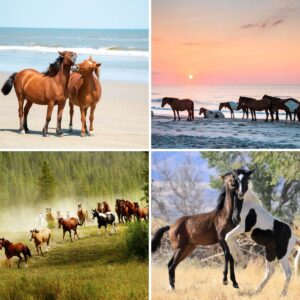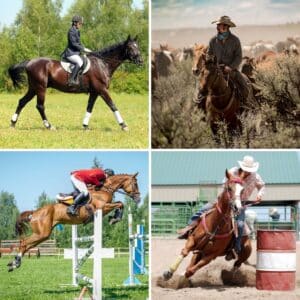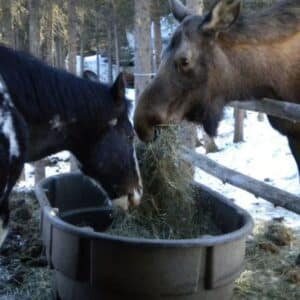Is a mare more difficult under saddle than a gelding? Opinions vary from person to person within the horse industry. Some feel mares can do anything the geldings can do, sometimes better. Others say the estrus cycle of mares makes them not worth the trouble. The Sydney School of Veterinary Science, in Australia, recently did a study to determine if mares are more difficult under saddle than geldings. Here is what they found out.
The Goal of the Study
Within the horse industry, there are preconceived ideas about a horse’s behavior, temperament, and rideability based on the sex of the horse. Some riding disciplines prefer mares and other disciplines prefer geldings. The study set out to determine if there were grounds for this gender bias.
Do you have a gender bias between mares and geldings? Does it affect your relationship with horses of a particular sex? The researchers are concerned that this kind of prejudice can lead to harsher training methods, particularly towards mares. Mares who are perceived as bossy will often time receive an increase in punishment. In addition, different disciplines, like the racing industry, are more likely to send mares with bad attitudes to slaughter when compared to horses with injuries and poor performance. If the study showed no grounds for this gender bias, the researchers wanted to let it be known to the horse industry worldwide.
The Questionnaire
To carry out the study, nine experts in the horse industry developed a questionnaire called the E-BARQ, which stands for the Equine Behavior Assessment Research Questionnaire. The panel consisted of experts in veterinary science, horse training, horse welfare, elite-level competition, equestrian coaching, equitation science, and equine behavior.
Two of the panel members discussed the E-BARQ during the International Society for Equitation Science’s August 2020 virtual meeting. Paul McGreevy, BVSc, Ph.D., FRCVS, MACVS (Animal Welfare), Cert. CABC, Grad Cert Higher Ed, a professor at the University of Sydney, and Kate Fenner, BEqSc (Hons), a Ph.D. candidate, had this to say:“What we’re trying to do with E-BARQ is develop a database that’s large enough to get past respondent bias (a tendency to respond to questions inaccurately) and show which horse management and training traditions stack up and which ones we need to get rid of. In addition to the welfare aspect, the more we understand horse behavior, the safer we can be around them.”
Taken online, the E-BARQ has other uses for researchers and horse trainers. This article, written by Kate Fenner for Horse and People, further describes the benefits of the E-BARQ.
The questionnaire can be used by horse owners and trainers to monitor how their horse’s behaviors respond to different training techniques over time. You are encouraged to complete the survey every six months to see how your horse’s behavior is responding. If the response is not favorable, then maybe a different training technique should be considered.
1,233 Results Studied
Let’s get back to the study. The research team examined 1,233 questionnaires to determine the results. The E-BARQ has two sections: ridden (268 questions) non-ridden (218 questions). The research team chose 151 questions, which pertained to potentially problematic behaviors on a scale of one to five. Participants were unaware of which questions would be used for the study.
Those 151 questions were further broken down to a horse’s behavior while not being ridden and while being ridden. For example: is the horse willing to be caught, does he stand quietly, or does he move around while being saddled? Does the horse need a behavioral warm-up period? (This is often called “cold back”.) Does he argue about transitioning into different gaits? Those results were then divided by mares and geldings.
The Results
After reviewing and rating the questions, the researchers found that there was a less than 5% difference between mares and geldings on most questions. On the few questions in which there was a more considerable difference, the geldings had more unwanted behaviors. Oddly enough, these behaviors were all while not being ridden.
Here are a few of the unwanted behaviors where geldings scored higher:
20% more likely to chew ropes when tied
12% more likely to chew saddle pads
12% more likely to move around when being clipped
10% more likely to be food aggressive toward handlers
According to the study, the answer to the question, “Is a mare more difficult under saddle?” is no. In fact, there is not much difference between mares and gelding under saddle. However, geldings showed more unwanted behaviors while not being ridden than mares.
Horse Courses by Elaine Heney
- Listening to the Horse - The Documentary by Elaine Heney & Grey Pony Films
- Shoulder In & Out Training for better balance, bend & topline development with your horse
- Over 110+ Polework Exercises & Challenges to Download
- Dancing at Liberty & Creating Connection with Your Horse (11 lessons) - Grey Pony Films
Final Thoughts
There definitely is a strong bias in the horse industry for horses of different sexes.
Personally, I have mostly worked with mares. Nothing against geldings; I just have had more opportunity to work with mares. This study was long overdue, and hopefully, it will open the eyes of the horse industry. It was good to see that the ladies won this battle, and mares are not more difficult than geldings under saddle.








